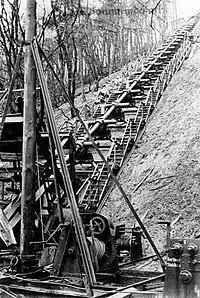Land Battleships: Ever Hear of the V-3 Super Gun? Big Artillery, So You Don't Go Broke
Royal Navy Commander Ian Fleming did not create deep underground military bases (DUMBs) from an over-active imagination for his fictional hero James Bond to locate and destroy--he learned of actual bases during his intelligence work during WW2--and he sent actual 007s from his 30 Assault Unit to recon and destroy them. Craig Cabell has done a great job researching Fleming and his men thwarting the German V-1 cruise and V-2 ballistic missiles in his books, The History of the 30 Assault Unit and Ian Fleming's Secret War. However, he missed the V-3 which was a long-range artillery CANNON designed to hit London with up to 300 shells per hour from Calais, France still under German control.
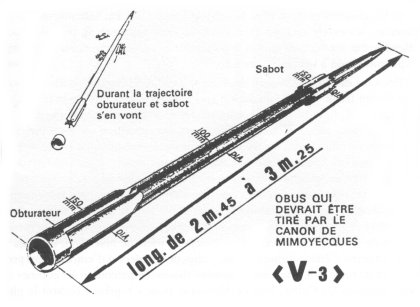
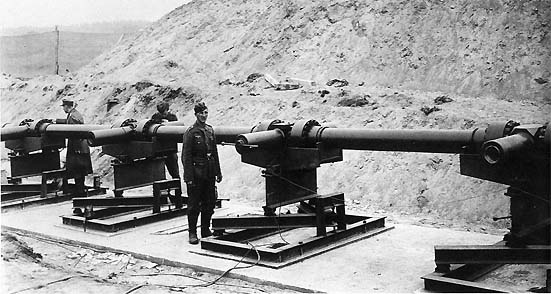
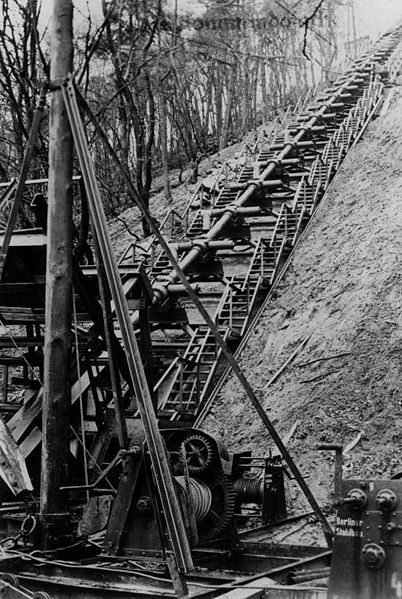
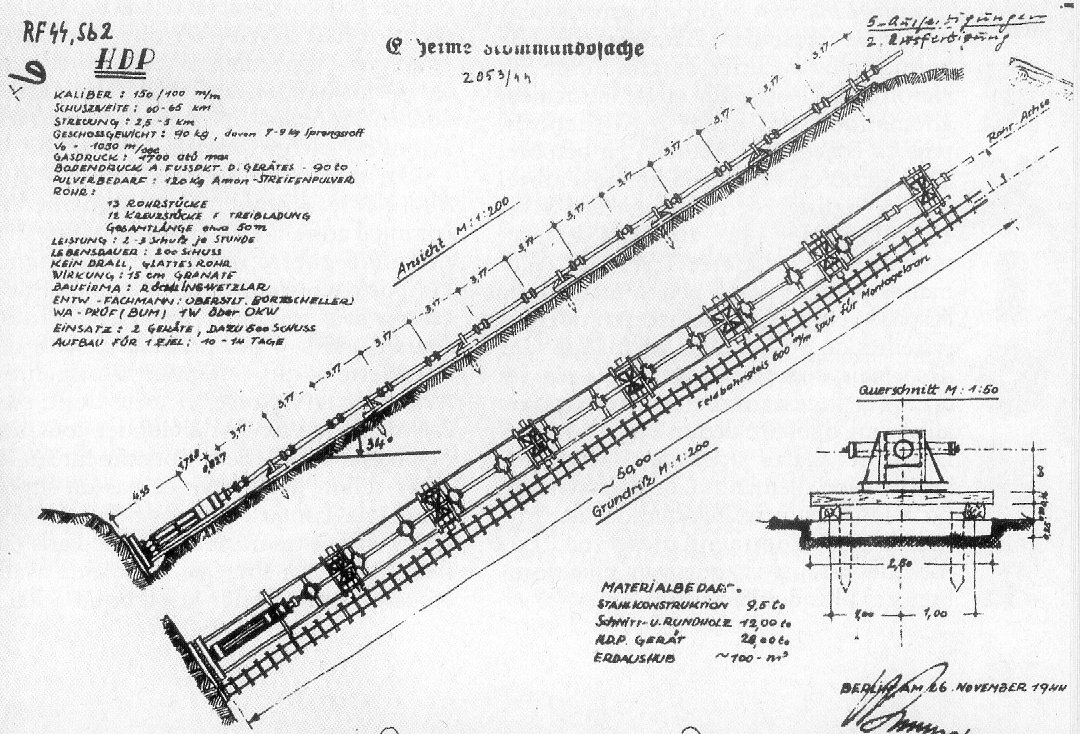
Artist's Cut-away Drawing of the V-3 Underground Site
Anthony Cave Brown in his ground-breaking book Bodyguard of Lies revealed in 1975 (30 years after end of WW2 for a category of Official Secret Acts information to become available) that we cheated to win WW2 by breaking the German codes with the ULTRA intercepts. His book is more than just about ULTRA, it details the entire covert war to defeat the Axis including a description of the V-3.
http://en.wikipedia.orghttp://en.wikipedia.org/wiki/V-3_cannon
From Wikipedia, the free encyclopedia 
V-3 cannon
|
Hochdruckpumpe (high-pressure-pump)[1] |
|
|
http://en.wikipedia.org//wiki/File:Bundesarchiv_Bild_146-1981-147-30A,_Hochdruckpumpe_V-3.jpg
|
|
|
Type |
|
|
Place of origin |
|
|
Service history |
|
|
In service |
1944 - 1945 |
|
Used by |
Nazi Germany |
|
Wars |
World War II |
|
Production history |
|
|
Manufacturer |
|
|
Specifications |
|
|
Length |
130 metres [3] |
|
|
|
|
140 kg |
|
|
150 mm |
|
|
300 shells per hour (projected) |
|
|
1,500 m/s |
|
|
Maximum range |
165 km |
http://en.wikipedia.org/wiki/File:V-3.cannon-installations.Miedzyzdroje.2.JPG
2008 photo of remains of V-3 in Zalesie near Międzyzdroje,
Wolin Island, PolandMain article:
VergeltungswaffeThe V-3 (
Vergeltungswaffe 3), also known as the Hochdruckpumpe ("High Pressure Pump", HDP for short; this was a code name used to hide the real purpose of the project) and Fleissiges Lieschen ("Busy Lizzie"),[4] was a German World War II supergun working on the multi-charge principle whereby secondary charges are detonated to add velocity to a projectile.The weapon was planned to be used to bombard
London from two large bunkers in the Pas-de-Calais region of northern France, which were rendered unusable by Allied bombing raids before completion. Two similar guns were used to bombard the country of Luxembourg from December 1944 to February 1945.The basic construction was later taken up in the U.S. and Canada by developments like the
Project HARP in the 1960s.
Contents |
Description of V-3
The gun used multiple propelling charges placed along the barrel's length and timed to fire as soon as the projectile passed them by, to provide an additional boost. Due to their higher suitability and ease of use,
V-3 Booster charges
Unlike conventional rifled weapons of the day, the smooth-bore gun fired a fin-stabilized shell, dependent upon aerodynamic rather than
In 1943, German engineer
Cönders was ordered to produce a prototype of the Hochdruckpumpe ("high-pressure-pump")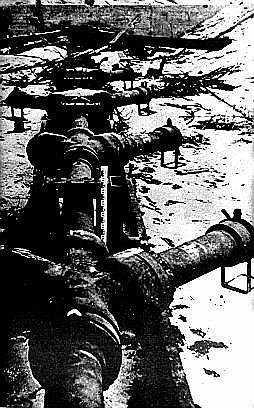
Development
Test V-3 SuperGun
Cönders had constructed a full-calibre gun at the
Six different companies including
Trials were held at Misdroy from May 20-24, 1944 with ranges of up to 88 km being attained.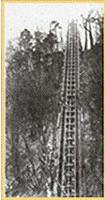
Mimoyecques site
Following Hitler's decision that HDP guns be sited in northern France to bombard London, the task of finding a suitable site for the HDP batteries was given to Major Bock of Festung Pioneer-Stab 27, the fortification regiment of LVII Corps, Fifteenth Army, at the time based in the Dieppe area. A study in early 1943 concluded that a hill with a rock core would be most suitable, as the gun tubes could be placed in drifts (inclined tunnels) and support equipment and supplies located in adjacent tunnels. The guns would not be movable, and would be permanently aimed at London.
A suitable site was selected at a 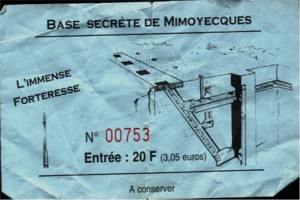
Aerial reconnaissance photographs taken on 18 September 1943 of "Marquise-Mimoyecques" (as the site was called in Allied documents) showed suspicious activity that had not appeared on earlier images taken on 2 September. The 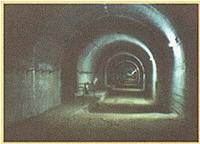
Air Recon Photo of the V-3 Site
A detailed study of the site was conducted on 13 November 1943, which concluded that it was a new type of site and the only one of its type so far discovered. The report described at length the railway facilities under development as well as eight strange structures which were identified as the covers for rocket launch tubes. These were in fact the covers for the HDP gun shafts.
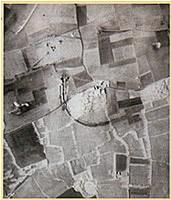
Although the bombing of the site had little effect, Allied air attacks on communication networks and industrial centres had slowed down German economic activity [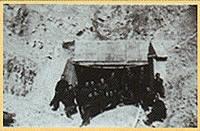
Daylight USAAF B-17 Bombing of the V-3 Site
It was therefore decided to scale back the project by stopping work on the western site before any shafts had been created and concentrate instead on the eastern site.
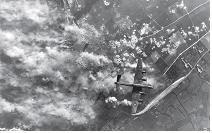
V-3 Firing Battery: How a HE-filled B-17 or B-24 was to Dive Into This by Remote Control Seems Difficult and Unlikely to Succeed
The eastern complex consisted of five drifts angled at 50 degrees reaching 105 metres (344 ft) below the hilltop. The five drifts exited the hilltop through a concrete slab 30 metres (98 ft) wide and 5.5 metres (18 ft) thick. Large steel plates protected the five openings and each drift had a special armoured door. Extensive tunnels and elevator shafts supported the guns, and had the site become operational about 1,000 troops from Artillerie Abteilung 705 and supporting units would have been deployed at Mimoyecques. Artillerie Abteilung 705 had been organised in January 1944 under Oberstleutnant Georg Borttscheller to operate the Wiese gun complex.
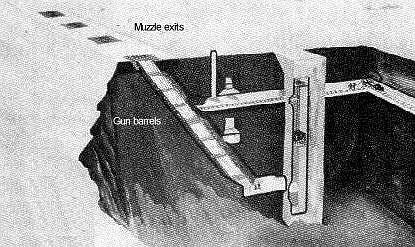
The plans were to have the first battery of five gun tubes ready for March 1944, and the full complex of 25 gun tubes by 1 October 1944. However, following a failure at the Misdroy proving ground in April 1944 after only 25 rounds had been fired, the project was further cut back, from five drifts to three even though work had begun on some of the other drifts. The site was finally put out of commission on 6 July 1944, when bombers of The "Dam Busters" Do it Again!

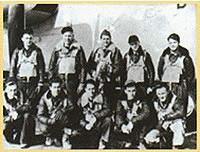
Tallboy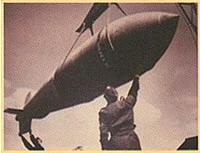
One Tallboy directly impacted the concrete slab on top of the complex, collapsing Drift IV, and three other Tallboys penetrated the tunnel system below creating extensive damage. Some effort was made to clean up the debris, but by late July it was obvious that the damage was too severe to justify continuing construction, since the RAF could well conduct further Tallboy raids.
Damaged V-3 Site Tunnel
Plans were made to reconstruct the gun battery at the Rixtent B81 liquid oxygen facility, but this never occurred. The Allies were, however, unaware that work had ceased at Mimoyecques, and further missions were flown against the site. A mission was flown on 6 August 1944, as part of Never formally abandoned, the Mimoyecques site was overrun by the 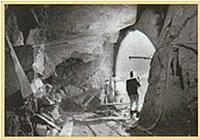
|
Bombing of Mimoyecques during World War II |
|||||
|
Date |
Result |
|
|
|
|
|
5 November 1943 [10] |
USAF Ninth Air Force bombs "construction works" at Mimoyecques; poor visibility causes one group to bomb area southwest of primary target and bad weather causes numerous aborts.[10] |
|
|
|
|
|
11 November 1943 |
387th Bombardment Group records indicate Operation Crossbow bombing of the "Martinvast V-1 site" [sic] on November 11, 1943,[11] one of two November 1943 bombings of the large Mimoyecques site under construction at Martinvast.[12] |
|
|
|
|
|
10 April 1944 [10] |
USAF Eighth Air Force attacks "a V-weapon site" at Mimoyecques.[10] |
|
|
|
|
|
28 April 1944 [10] |
47 B-24s of the Eighth Air Force bomb V-weapon site at Mimoyecques.[10] |
|
|
|
|
|
1 May 1944 [10] |
129 heavy bombers of the Eighth Air Force attack V-weapon sites at Mimoyecques, Watten, and Bois de l'Enfer.[10] |
|
|
|
|
|
15 May 1944 [13] |
Mission 356: 166 bombers and 104 fighters hit V-weapon sites in France with 1 fighter lost; 38 of 58 B-17 Flying Fortresses bomb Mimoyecques with 5 B-17s damaged; escort is provided by 104 P-51 Mustangs with 1 lost (pilot is MIA).[14] |
|
|
|
|
|
21 May 1944 [15] |
Mission 360: 150 bombers and 48 fighters hit V-weapon sites in France without loss; 25 of 40 B-17s of the Eighth Air Force [10] bomb Mimoyecques and 13 B-17s are damaged; 99 of 110 B-24s hit Siracourt and 1 B-24 Liberator is damaged. Escort is provided by 48 P-47 Thunderbolts without loss.[14] |
|
|
|
|
|
22 June 1944 |
234 aircraft - 119 Lancasters, 102 Halifaxes, 13 Mosquitos - of Nos 1, 4, 5 and 8 Groups to special V-weapon sites and stores. The sites at Mimoyecques and Siracourt were accurately bombed by 1 and No 4 Group forces with Pathfinder marking but the 617 Squadron force attacking Wizernes, failed to find its target because of cloud and returned without dropping its bombs. 1 Halifax lost from the Siracourt raid.[16] |
|
|
|
|
|
6 July 1944 |
No. 617 Squadron RAF[17] attacked with Tallboy bombs, hitting one of the shafts and blocking galleries with earth and debris[7][16] |
|
|
|
|
|
4 August 1944 |
The first Operation Aphrodite mission is flown using 4 radio-controlled B-17s as flying bombs; none of the targets are hit; 1 B-17 drone crashes killing 1 crewmember. Escort is provided by 16 P-47 Thunderbolts and 16 P-51 Mustangs.[14] |
|
|
|
|
|
12 August 1944 |
An U.S. Navy Project Anvil BQ8 (ex PB4Y-1 BuNo. 32271/ex USAAF B-24J 42-110007)-- detonates prematurely over the Blyth Estuary, England, killing Lt. Joseph P. Kennedy, Jr. and Lt. Wilford J. Willy |
|
|
|
|
Luxembourg bombardment
SS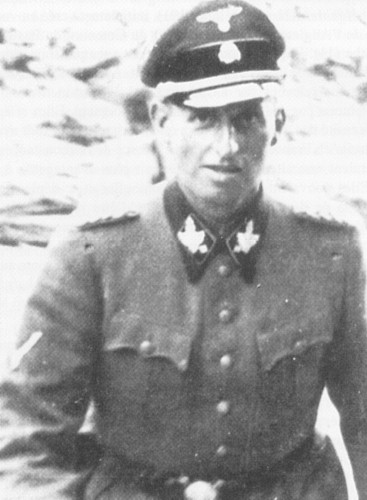
The project eventually came under the control of the SS and SS General
Hans Kammler ordered the project to be ready for action in late 1944.
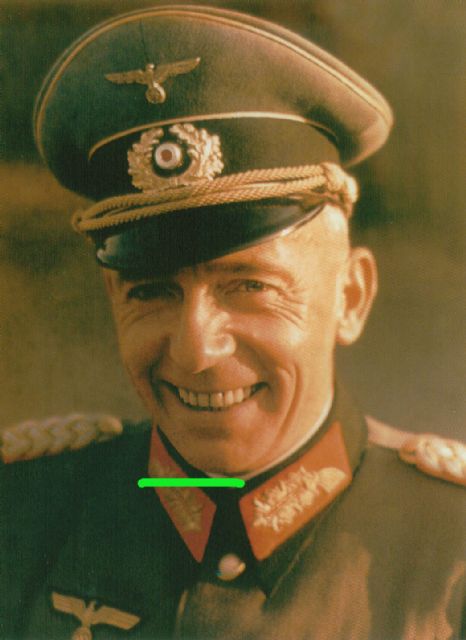
General Dornberger-later VP of Bell Aircraft thanks to Operation PAPERCLIP
Assisted by
Walter Dornberger, a battery of two shorter guns approx. 50 metres (160 ft) long with 12 sidechambers were constructed and placed in the hands of the army artillery unit Artillerie Abteilung 705 under the command of Captain Patzig. These were sited in a wooded ravine of the Ruwer River at Lampaden about 13 kilometres (8.1 mi) southeast of Trier in Germany.[18]The two guns were aimed west, resting on 13 steel support structures on solid wooden bases on a 34 degree slope. The city of
Luxembourg (which had been liberated in September 1944) was at a range of about 43 kilometres (27 mi) and was designated Target No. 305. Between the two gun tubes concrete blockhouses were constructed as well as ten smaller bunkers to hold projectiles and propellant charges.Actual V-3 Projectile
The assembly and mounting of the Lampaden guns coincided with the final preparations for the
By the time the Ardennes offensive began on 16 December 1944, Kammler received orders from 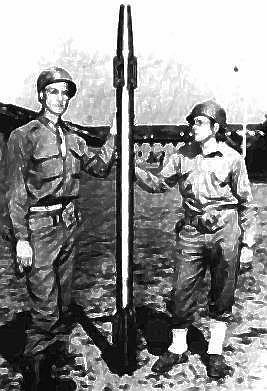
Captured V-3 Projectile in Crate
The second gun tube was brought into operation on 11 January 1945 and in total some 183 rounds were fired until 22 February 1945, with 44 confirmed hits in the urban area. The guns were not particularly effective; of the 142 rounds that impacted Luxembourg, total casualties were 10 dead and 35 wounded. One gun was dismantled on February 15,
A second battery of guns began to be deployed in January 1945 at
There were other proposals to deploy batteries to bombard
The Mimoyecques museum allows visitors to view the galleries (in various stages of construction and bombing damage), remains of the guns, a small scale V-3 replica, and examples of machinery, rail systems and tools employed. The site also contains memorials to the slave-laborers who were employed by the Nazis to construct it, The 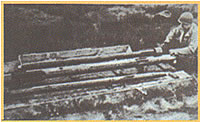
Final fate
V-3 Museum
Trivia
John F. Kennedy's elder brother, Lt. Joe Kennedy died when the Operation Aphrodite drone he was piloting blew up on a mission to bomb the Mimoyecques V-3 site
References and notes
a b Thompson, Peter (1999). The V-3 Pump Gun. London: ISO Publications.
Brown described the V-3 as being built deep underground and only had openings for the guns that were covered by 8 inch thick steel doors. Had they been fully completed they would have been impervious to unguided high explosive (HE) bomb attacks like the U-Boat (submersible) pens were.
www.combatreform.org/highexplosives.htm
Brown says Allied medium bombers were sent at low altitude for better accuracy than the typical high altitude attacks to smash the V-3 batteries before they could be completed, and successfully thwarted their employment. This differs from the WIKI account that we were able to get direct hits with very large Tallboy bombs dropped by 617 Squadron the "Dam Busters" heavy Lancaster bombers to smash the sites. We tried to ram HE-laden bombers by radio remote control into the V-3 site but had to first take-off under human control resulting in the death of the first Kennedy brother, Joseph Junior. The Germans figured out the best way to do the remote control bomber approach was by having the take-off pilot on top in a parasite fighter and have it detach so he could fly away instead of trying to parachute bail-out.
www.combatreform.org/axisandalliedspecialoperationsaviation.htm
Now today, Nazis here in America would boast that such long-range tube artillery would be easily smashed by precision guided munitions (PGMs). I'm not so sure. The approach we are taking to PGMs of FLYING THEM in throw-away airplanes (V-1 mentality) or guided rockets AKA missiles (V-2 mentality) is making the Rockefeller Neocon Nazi military-industrial complex (MILINDCOMP) rich and America go broke. Its also ruining the USAF, Navy and marines who are cowardly avoiding men in cockpits in the air to investigate, find and destroy the enemy in favor of unmanned air vehicles (UAVs). If we are going to chicken out of men flying in the air/space to do the things that only they can do from that dimension for ARTILLERY, the best way to do artillery is with BALLISTIC ARTILLERY that is affordable and can be employed in quantity.
Could the V-3 Have forced England to a Negotiated War End?
Strategic bombing of civilians to if not destroy their war-making factories and resources to terrorize them into surrender has not worked with unguided high explosive bombs. By 1943 both the Axis and Allies knew this, but the latter continued despite huge losses in men and aircraft because it was having at least some dampening effect on the German high-technology weapons programs. The one time strategic bombing has made a nation-state cry "uncle" was when we dropped super high explosive (SHE) nuclear bombs on Japan in 1945. With Hitler unable to invade England in 1940 with MANEUVER due to the men of the RAF denying him air supremacy to make it safe fore his ground forces to cross the water channel and weakened by Allied maneuvers from both the East and West, he looked to a FIREPOWER answer to get the Allies to stop the war. The conventional history is that heroic SOE British/Norwegian commandos, "The heroes of Telemark" smashed the German's heavy water facilities and sank their supplies in a ferry and they never were able to sustain a chain reaction to figure out how to make a bomb.
Video Playlist
 www.youtube.com/user/familyphotoshoot#grid/user/59240BF4F0A80B06
www.youtube.com/user/familyphotoshoot#grid/user/59240BF4F0A80B06
Dr. Joseph Farrell says differently: America didn't need heavy water to create a reactor and went on to develop nuclear bombs, and even makes the case that GERMANY ACTUALLY DID EXPLODE A NUCLEAR BOMB IN WW2; they simply couldn't produce enough purified uranium to exploit it to get strategic effects:
www.combatreform.org/black_sun.htm
In fact, America was in even worse shape in regards to enriched uranium and HAD TO USE CAPTURED GERMAN URANIUM TO MAKE OUR BOMBS WE DROPPED ON JAPAN--before they surrendered. Churchill and many others believed that naval sea mine blockade surrounded Japan terrified rightly of Stalin's Communist Russia declaring war on them in 1945 with Germany finished was going to surrender anyway.
PGM pundits of the Rockefeller Neocon Nazi University of Chicago will claim that we can get nuclear effects without the massive civilian casualties, devastated areas and long-term radiation poisoning by employing HE bombs with DIRECT HIT PRECISION. These RMAophiles claim all we have to do is BOMBARD an enemy with PGMs and can then roll in troops in flimsy trucks and occupy the place. The question is if the German V-1s and V-2s could be controlled to strike specific buildings like WhiteHall etc. could they have forced England to sue for peace?
www.combatreform.org/PGMsareNAZI.htm
The facts appear to be NO. Much of England's war effort was already underground and even a direct hit would not destroy their key nodes. The HE missile's QUANTITY of explosive effect is simply not enough to bombard a hardened enemy nation-state into submission by FIREPOWER WITHOUT MANEUVER. The German position of being unable to MANEUVER and to try to win wars by HE FIREPOWER alone--even with direct hit precision cannot work unless the QUANTITY of explosive power is greatly magnified for MASS DESTRUCTIVE effects via nuclear, biological or chemical (NBC) warheads.
This is why to date we have yet to see a surface-to-surface ballistic missile war with conventional HE warheads be fought between two nation-states to a decisive conclusion. Iraq and Iran shot SSMs at each other in their 1980-88 war but neither wiped out enough people to force a surrender. NBC warheads are another matter and a dire threat particularly India vs. Pakistan which are set to kill each other and comply with the Illuminati's Malthusian wishes for global depopulation by potentially murdering 2 BILLION people out of the 6 billion they want to see vanish so the remaining 1 billion can have more elbow room.
So How Can You Win a War Against Hardened Enemies and Not Go Broke?
Guided missiles are too expensive and not powerful enough to build in enough quantity to overcome hardened enemies; the dilemma the Iranian nuclear program poses dispersed over 40 different locations and underground is a prime example. Lots of James Bond recce units in light tracked tanks with C4ISR means would be needed to direct aircraft strikes or do their own attacks.
www.combatreform.org/reconinforce.htm
Some of these aircraft will be shot down and men lost. Why should we lose men in aircraft if all they are doing is conveying HE from point A to B like a dump truck?
Caveat. Black propaganda should be directed at the Iranian people reminding them Islam is a bogus religion exploited by religious tyrants like Fleming did in the Political Warfare Executive (PWE) to remind the German people that Nazi fascism was wrong in WW2. A secular and sane Iran would not pursue nuclear weapons and could defend itself from its oil being taken away from it with a skilled military and armed populace. Many nations see nuclear weapons as a nation-state survival insurance policy, but this will vanish once the first countries try to cash in on the "policy" and "collect" nuclear annihilation.
Land Battleships
The German military knew what to do to smash hardened foes with enough heavy HE firepower and not go broke: bring in heavy tube artillery--like they did with massive cannon to take Sevastapol. Usually this is done on railroad cars to get enough transportation conveyance for the massive cannon and recoil mechanisms. Today, we could be even more mobile without being tied to railroad lines with wheeled transporters like "Atomic Annie" or better yet tracked ones. We should have mobile, long-range, artillery cannon on tracks in the USMIL capable of bombarding enemies from ranges of 50-100 miles so we can land by air or seacraft and take-up firing positions to bombard a capital city and/or specific military targets into submission WITHOUT HAVING TO FLY FIGHTER-BOMBERS OR LAUNCH MISSILES TO TRY TO DO THIS INEFFICIENTLY. We need to be able to lob $1K shells by the thousands--not $1M missiles by the dozen.
Let me be perfectly clear, YES we need a MASSED (a lot of it) ground tube artillery capable of strategic-operational bombardment in lieu of fighter-bombers and guided missiles. These are some of the siege engines British General Francis Tuker warned that we lacked in WW2 to our detriment that we must have to prevail in future city combats:
www.combatreform.org/thepatternofwar.htm
If we have say an intransigent Iran unwilling to stop its nuclear weapons program, we could land a force that would just be there to bombard their specific hardened targets--not necessarily march on Teheran and do regime change that invites occupation and rebellion. Consider it a "land battleship" that can reach farther and reach targets than our Iowa class battleships cannot reach from the sea.
www.combatreform.org/battleships.htm
YES, they should be brought back into service so we can properly bombard foes from the water's edge--and not go broke trying to do it with expensive PGMs. What the Iowa sea battleships can't reach, the land battleships strike. PGM artillery shells that are lobbed ballistically from high pressure gun tubes are still far cheaper than PGM missiles that have to fly themselves to target.
Atomic Annie: Time for a Modern, Tracked Equivalent
 www.youtube.com/view_play_list?p=211CD4083425828D
www.youtube.com/view_play_list?p=211CD4083425828D
As LTG Gavin learned from the German V-2 ballistic missile experience mobile launchers are the easiest way to avoid destruction by avoiding detection in the first place. The problem is the maximum range of tube artillery that can be at least rail-mobile is about 25 miles. To reach London from Calais, the Germans needed 100 miles and a fixed firing site--this would have to be protected and underground to avoid destruction--and the Germans almost pulled it off had the Allies not struck first.
Why Waste Money on This For War? What Good Would this be for Peace?
This story was repeated years later in Iraq when Canadian artillery expert Gerald Bull (who advanced German research after WW2 with Project HARP) was unwisely helping Saddam Hussein build a "SuperGun" cannon to reach Israel. Bull was assassinated and fortunately the project didn't get put into action.
 www.youtube.com/view_play_list?p=B1D50305D977F980
www.youtube.com/view_play_list?p=B1D50305D977F980
Bull's dream to put affordable satellites into Earth orbit is a good one--he just couldn't get the necessary funding to pull it off--it seems human beings are more interested in killing each other. With anti-gravity craft (AGC) and zero point energies (ZPE) under wraps and denied to the common folk, chemical means are still the only available means to get into space and we should overcome this by innovating. Rutan's air-launch of spaceships to get the boost of atmosphere density is something the Germans realized too before the unsafe von Braun zero-to-hero rocket mentality became wise-spread.
Von Braun & Dornberger Launch the Rocket Space Age: In America--Not Germany
V-2 SSM; Dornberger & Von Braun


Von Braun & President Kennedy Look Skyward

Using a mag-lev train track/sled to get ski-launch velocity is another good idea.
 www.youtube.com/watch?v=zIgMZ-Tj7eA
www.youtube.com/watch?v=zIgMZ-Tj7eA
One of the missions of the Army's Land battleships would be to launch small satellites into low Earth orbits in emergency during war, and to spin-off civilian satellite launching guns which could be fixed and even bigger to launch bigger satellites. Maybe even large enough to launch people--as Jules Verne said all along in From the Earth to the Moon?
Verne's Ballistic Shell Moon Ship
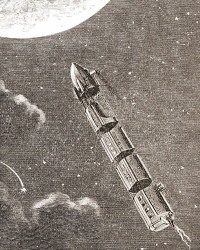
 www.metacafe.com/watch/1801310/a_trip_to_the_moon_1902/
www.metacafe.com/watch/1801310/a_trip_to_the_moon_1902/
www.youtube.com/watch?v=7JDaOOw0MEE
A Trip to the Moon (French: Le Voyage dans la lune) is a 1902 French black and white silent science fiction film. It is loosely based on two popular novels of the time: From the Earth to the Moon by Jules Verne and The First Men in the Moon by H. G. WellsThe film was written and directed by Georges Méliès, assisted by his brother Gaston. The film runs 14 minutes if projected at 16 frames per second, which was the standard frame rate at the time the film was produced. It was extremely popular at the time of its release and is the best-known of the hundreds of fantasy films made by Méliès. A Trip to the Moon is the first science fiction film, and utilizes innovative animation and special effects, including the iconic shot of the rocketship landing in the moon's eye
It was named one of the 100 greatest films of the 20th century by The Village Voice, ranking in 2001
This Version features a Soundtrack by Erich Wolfgang Korngold & Laurence Rosenthal
If we had a moral and an efficient USMIL, we would employ cost-effective guns on ships and on land to bombard enemies with accuracy and overwhelming power. Since the USMIL is an immoral RACKET that wants to maximize profits and keep wars in play rather than win and smother them, we sling increasingly expensive PGMs at our conveniently-created Islamic dragons to slay.
If providing access to space at the most affordible way possible was a priority to the Illuminati, cannon-launched satellites would already be a reality. More monies are to be made with expensive action--->reaction rockets from zero altitute and zero speed and this provides a ready-made excuse why WE THE SHEEPLE need to stay bogged down here on Earth working ourselves to death and paying taxes to the Illuminati. Is there a way we can FIRE ATLAS--instead of waiting for the Illuminati to go on strike (like waiting for Hell to freeze over) as outlined in Ayn Rand's book?
NOTES
1. Bodyguard of Lies, pages 368-370
